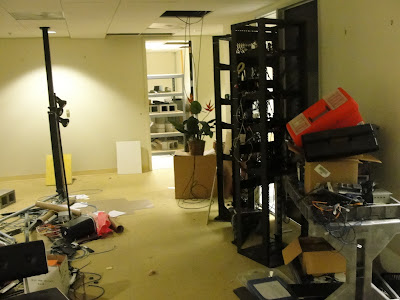
I spent three days last week as the corporate functionary dispassionately watching a crew clear out the remaining furniture, demolish a server room, destroy stacks of unneeded computers, hack bundles of wire from the walls and ceilings at the office of my former company, IMMI, in San Mateo. No, I'm still employed myself, happy about that but melancholy over the finality. The fact is, I’ve been the last man standing a number of times now. Seeing treasures turned to mud again, it took me back down Hwy 101 into the valley of memories.
It’s the same as it was when I worked for SCT, I started in the computer center in 1985, even then it was about obsolescence, miles of cat-2 wire and coaxial cable that no one could use any longer, no matter how expensive it originally had been, no matter how much those who installed it had sweated and cherished it.
I believe I did escape the period in Local Area Network history in which the wall-mounted DB25 connectors were soldered to the 8-conductor phone wires that had been pulled through the ceiling. This actually involved close-up work with a soldering iron while laying on the floor. And Eric wonders why he has those headaches…
Yes, we were real men who ran the LAN in those days, Eric and I constantly pushing fat yellow coaxial Ethernet cable through jammed conduits, thick as a pinky, stiff as a dick, we even had an evil black lubricant to aid its passage into the building’s secret orifices.
Imagine what chumps we felt like when it was revealed a few years later that you can run Ethernet fine over a few strands of telephone wire. Well. That was fun. More like bewildered a few years after that, bitter, really, when suddenly there were no wires required at all.
The period I remember was especially after we became SCT and moved to “A” and “B” buildings under General Pauley’s guidance. The former Defense and Aerospace divisions were split between the two buildings, a metaphor for their uneasy business relationship. As a telephone, LAN, desktop support lackey I was intimate with the mother building, the physical plant.
The buildings still stand, “A” a two-story faintly California architected office structure, one of the first established in the nascent Stanford Industrial Park. It was above ground, constructed from solid dimensional redwood, while “B”, where the raised floor computer room was, was subterranean concrete.
I still sometimes dream about a space between the B and C buildings in which some important and obscure telephony took place, which Eric installed and I eventually reverse engineered, not too long ago I dreamed that Eric rehired me to SCT, despite my advanced age and incompetence that old knowledge suddenly meant something again.
It did occur to me that it would not be cool to spy on the women’s bathroom, so I didn’t try to do that, but a life in the floors and ceilings does convey a keen sense of omniscience. Often I would retreat to my phantom zone, a 4 ft. crawlspace between floors to read and smoke cigarettes by flashlight, a maze of thick boards nailed to the ceiling joists leading deep into the darkness. Along the way were distributed isolated banks of the diode matrixes used for the 6-button executive telephones of the time, easy to monitor with a clip-on phone ( I didn’t really spy on anyone). The air was stale and still, muffled sounds from above and below.
I spent a lot of time in ceilings and on floors anyway, it’s funny that my career in the corporate world has also always involved knowing a lot about everything everyone is doing in the organization, this fly-on-the-wall perspective is another metaphor for that. One of the most amusing examples of this was an evening in which I was working late, running an Ethernet cable for the Kestrel Institute, with whom we were associated. I was laying under a table, completely invisible when a young Artificial Intelligence geek sailed maniacally into the computer lab, lined with the towering Symbolics Lisp machines, terminals and printouts everywhere, dropping his bicycle heavily against the wall of the second story room, he’s hauled it up the stairs, buttonholing the only other person in the lab, Jeff, “Hey, you know about the P-NP problem, right?! I think I’ve solved it, I just had to tell someone…” I don’t know who that guy was, he didn’t solve it that night. Or was hit by the bus as he cycled home.
* The P versus NP problem is a major unsolved problem in computer science. Informally, it asks whether every problem whose solution can be efficiently checked by a computer can also be efficiently solved by a computer
There were many other spaces of invisibility like that, each with their allegorical lonely powers, one of my early crisises had me sobbing existentially in the wiring closet as I confronted a complexity that evidently could not be mastered, even by me. Another humbling lesson was my inability to master the above-mentioned 6-button phone with its simple diode-based logic matrix. Later we would just learn to ignore our inability to understand everything.





1 comment:
For what it is worth, I remember when I hired you. We were both working for different parts of a similar company and you wanted to get out of the mail-room/typing pool. You came by my office and said that you wanted to work for me, I said that I could not hire you because you were working for a sister company unless you got "permission" to come to work for us. Your response was to go and sit outside your company's presidents office until he came back from lunch and then you got permission. Glad that worked out you did a very good job for the time that you worked for me. It all ended when I got layed off, but that is another story.
Post a Comment